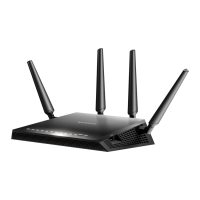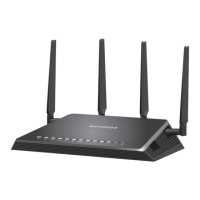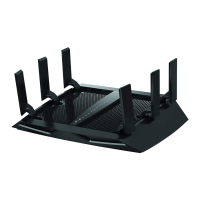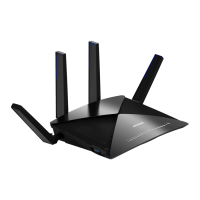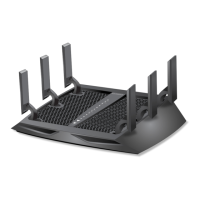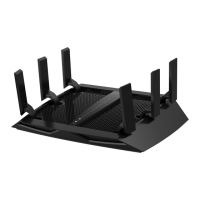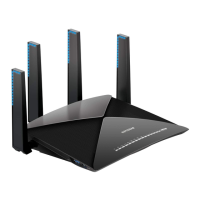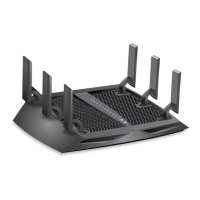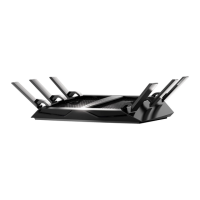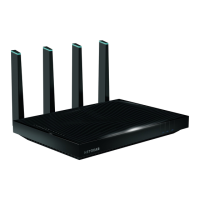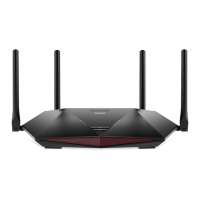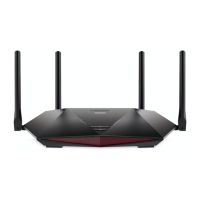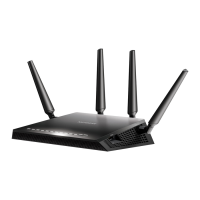
Do you have a question about the NETGEAR Nighthawk X4S R7800 and is the answer not in the manual?
| DSL WAN | No |
|---|---|
| Ethernet WAN | Yes |
| WAN connection type | RJ-45 |
| Security algorithms | WPA, WPA2, WPA2-PSK |
| Modulation | 256-QAM |
| Wi-Fi band | Dual-band (2.4 GHz / 5 GHz) |
| Wi-Fi standards | 802.11a, Wi-Fi 5 (802.11ac), 802.11b, 802.11g, Wi-Fi 4 (802.11n) |
| Top Wi-Fi standard | Wi-Fi 5 (802.11ac) |
| WLAN data transfer rate (max) | 1733 Mbit/s |
| WLAN data transfer rate (first band) | 800 Mbit/s |
| Product type | Tabletop router |
| Product color | Black |
| Cabling technology | 10/100/1000Base-T(X) |
| Networking standards | IEEE 802.11a, IEEE 802.11ac, IEEE 802.11b, IEEE 802.11g, IEEE 802.11n |
| Ethernet LAN data rates | 10, 100, 1000 Mbit/s |
| Ethernet LAN interface type | Gigabit Ethernet |
| Memory card slot(s) | - |
| Ethernet LAN (RJ-45) ports | 4 |
| USB 3.2 Gen 1 (3.1 Gen 1) Type-A ports quantity | 2 |
| Processor frequency | 1700 MHz |
| Power source type | DC |
| Supported network protocols | IPv6 |
| Number of products included | 1 pc(s) |
| Cables included | LAN (RJ-45) |
| Windows operating systems supported | Windows 10, Windows 2000, Windows 7, Windows 8, Windows Vista, Windows XP |
| Depth | 185 mm |
|---|---|
| Width | 285 mm |
| Height | 50 mm |
| Weight | 840 g |
Describes the contents of the router package, including the router, antennas, power adapter, and Ethernet cable.
Shows the location of status LEDs and buttons on the top of the router.
Details the connections and buttons found on the rear panel of the router.
Controls router status LEDs using the rear panel switch.
Attaching the router's four antennas for optimal performance.
Identifies the location of the two USB 3.0 ports on the left side of the router.
Identifies the location of the eSATA port on the right side of the router.
Connects an eSATA device using an eSATA cable to the router's port.
Optimal router placement for wireless signal range and performance.
Connects the router to the modem and power.
Auto-configures Internet settings via wizard.
Manually configures the router's Internet connection settings.
Sets up various IPv6 connection types for the router.
Adjusts the Maximum Transmission Unit (MTU) size for optimizing network performance.
Manages Internet access for network devices via parental controls.
Allows or blocks specific devices from connecting to the network.
Blocks specific Internet sites using keywords or domain names.
Manages lists of devices allowed or blocked from network access.
Schedules times for blocking specific Internet sites and services.
Configures email notifications for router activity and security events.
Configures Wide Area Network (WAN) settings for the Internet port.
Improves app compatibility by configuring a default DMZ server.
Changes the router's network name displayed in the file manager.
Modifies the router's Local Area Network (LAN) IP address and subnet mask.
Configures the range of IP addresses assigned by the router's DHCP.
Disables the router's DHCP server feature.
Assigns permanent IP addresses to specific devices on the LAN.
Connects devices to the WiFi network easily using the WPS Wizard.
Changes WiFi network name (SSID), password, and security options.
Changes the WiFi password and selects security options like WPA2.
Enhances WiFi performance with multiple clients by enabling/disabling MU-MIMO.
Reduces lag and improves streaming by enabling/disabling 160 MHz WiFi setting.
Enables a 5 GHz guest WiFi network for optimal HD streaming performance.
Adds a guest WiFi network for visitors to access the Internet.
Turns WiFi radios on/off via the front panel button or web interface.
Schedules when the router's WiFi signal should be turned off.
Configures Wi-Fi Protected Setup (WPS) settings for easy device connection.
Configures the router to function as a wireless access point (AP).
Sets up the router in bridge mode for faster WiFi connections.
Manages Internet traffic and prioritizes demands using Dynamic Quality of Service (QoS).
UPnP helps devices discover and connect to network services.
Prioritizes WiFi voice and video traffic using Wi-Fi Multimedia QoS (WMM QoS).
Checks for and installs new router firmware to update its software.
Changes the default administrator password for router login.
Enables password recovery for the admin account.
Recovers a forgotten admin password using security questions.
Views the router's current status and usage information.
Lists all computers and devices currently connected to the network.
Monitors and sets limits for Internet traffic volume.
Backs up, restores, or erases the router's configuration settings.
Enables and configures remote management access to the router over the Internet.
Lists requirements and supported file system types for USB devices with the router.
Connects USB and eSATA storage devices to the router.
Accesses storage devices connected to the router from a Windows PC.
Maps a connected USB device as a network drive in Windows.
Accesses storage devices connected to the router from a Mac PC.
Automates Windows PC backups using ReadySHARE Vault software.
Backs up Mac PCs to router USB drive using Time Machine.
Prepares and partitions a USB hard drive on a Mac for Time Machine backups.
Prepares a Mac computer for backing up large amounts of data with Time Machine.
Performs backups using Time Machine and a USB hard disk.
Sets up File Transfer Protocol (FTP) access for sending and receiving files.
Views and modifies network folders on a connected storage device.
Creates new network folders on a USB or eSATA storage device.
Edits existing network folders on a connected storage device.
Safely disconnects a USB device from the router.
Explains Dynamic DNS (DDNS) for remote access when IP addresses change.
Configures FTP access through the Internet for remote file access.
Sets up a personal FTP server using DDNS and a custom URL.
Registers for a free NETGEAR Dynamic DNS service account.
Configures the router with an already created Dynamic DNS account.
Changes the settings for an existing Dynamic DNS account.
Accesses USB storage devices remotely via the Internet.
Configures the router to act as a ReadyDLNA media server.
Plays music from a USB device using the router's iTunes Server.
Sets up router's iTunes Server to play music via iPhone/iPad Remote app.
Plays media files from a USB device connected to the router on a TiVo.
Installs printer drivers and connects the USB printer to the router.
Downloads the ReadySHARE Printer utility for Windows and Mac computers.
Installs the ReadySHARE Printer utility on computers sharing the printer.
Guides on printing documents using the NETGEAR USB Control Center.
Manages the status of connected USB printers.
Uses the scanning feature of a multifunction USB printer connected to the router.
Changes settings for the NETGEAR USB Control Center, like auto-startup.
Forwards incoming traffic to specific local servers.
Sets up port triggering for dynamic port opening based on outgoing traffic.
Establishes a virtual private network (VPN) connection for secure remote access.
Configures the router's VPN service settings before establishing a connection.
Installs OpenVPN client software on a computer.
Accesses the router's USB storage and media using a VPN connection.
Uses a VPN tunnel to access your home Internet service while away.
Initial tips for resolving common router problems.
Interprets router LEDs for diagnosing issues.
Resolves issues preventing login to the router's interface.
Diagnoses and resolves problems with Internet connectivity.
Solutions for when router configuration changes are not saved.
Isolates and fixes issues with WiFi connection.
Uses the ping utility to test network connectivity and diagnose issues.
Details default factory settings and how to restore them.
Lists the technical specifications of the NETGEAR Nighthawk X4S AC2600 router.
